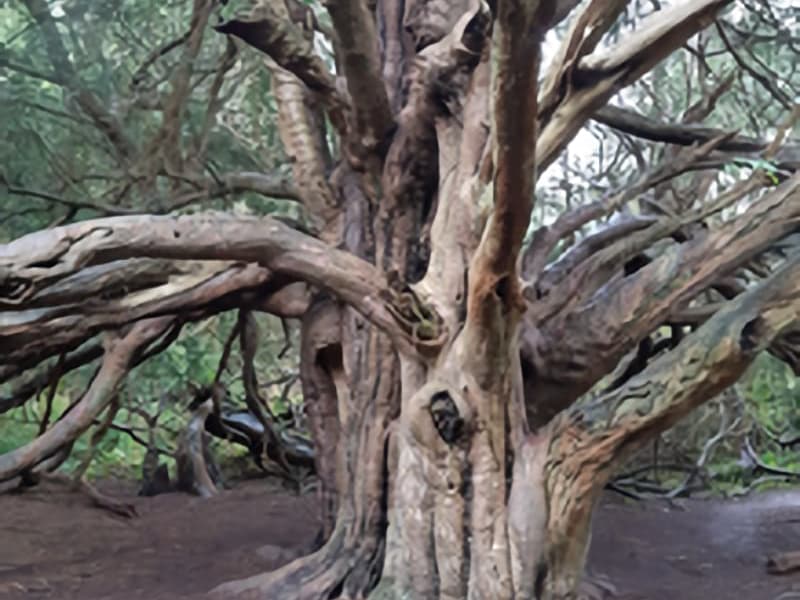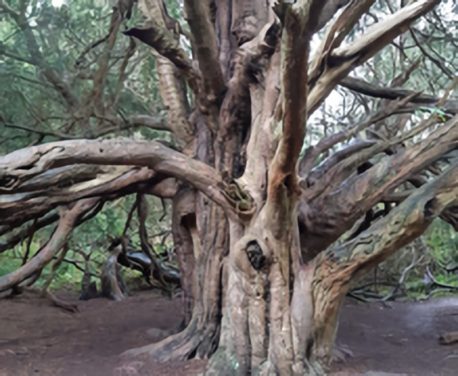Beneath many parts of the South Downs National Park lies a secret landscape revealing the lives of people who resided, visited and worked on the hills. This months featured trek explores the National Nature Reserve of Kingley Vale, which not only is one of Englands most important archaeological sites containing 14 scheduled monuments but also has a unique ancient Yew forest.
This moderate 9km (5.5 miles) trek starts at the West Stoke car park and follows a nature trail route around the reserve. From the car park take the well trodden path passing between arable fields for about 1km where a gate and wooden sculpture marks the start of the special area of conservation that is Kingley Vale. The nature trail starts by gently ascending through the centre of the Vale, where in the late 1800’s through to WW2 the enclosed hills were used as a military firing range. Evidence of this can be seen by the shrapnel marks in some trees and craters on the ground. In 1990 a clearance of the site removed over 6000 munitions of varying types.

Keeping to the eastern edge of the reserve the path passes through some of the oldest, gnarled and twisted trees, a short way on and the ascent becomes steeper leading you through more ancient Yew woods on the side of the Vale up to Bow Hill. The tangled grove of trees are amongst the oldest living things in Britain, several are at least 500 years old with some claiming to be between 900 & 2000 years old, the oldest of the Yew trees measure more than 5 metres in girth.
Very little daylight filters through the entwined branches which gives an eerie feel as you walk amongst them, the ground is very bare and carpeted with dry needles. At the top follow the wooded trail northwards for about 1km and take the Monarchs Way path downhill a short way to the iron age settlement of Goosehill Camp. The undulating ground hidden in the woods was once a small settlement probably for a family group, who may have only spent time here when tending to their flocks. The views from here in 500BC would have been fantastic across the valley and up to the Trundle Hill Fort.
Double back up the hill and take either path through the open access woodland back towards Bow Hill. Nestled in the woodland just below the summit is Tansley’s Stone, a memorial to 20th century ecologist Sir Arthur Tansley who was instrumental in the campaign to get Kingley Vale registered as a national nature reserve.
A few hundred metres to the west of Bow Hill are the Devils Humps (Kings Graves) the most familiar archaeological feature of Kingley Vale. These large tumuli are superb examples of bronze age burial mounds. There are four barrows in total consisting of bell and bowl barrows, the difference is down to the ditch that surrounds them, the bell barrow ditch is separated from the mound by a narrow step whereas the bowl barrows ditch take the shape of an upturned bowl. Many folklores and legends surround these barrows such as how the men of Chichester defeated a Viking war party in the Vale, the Viking leaders were buried in the Devil’s Humps hence their alternative name of the Kings Graves. Many of the Vikings died where they fell, under the Yew trees and on the slopes of the hill. Their ghosts are said to haunt the Yew groves, and the trees themselves are said to come alive and move at night. This folklore may have had its origin from a battle in AD 894 between the men of Chichester and the marauding Danes.
From the Devils Humps the route descends through Yew Tree Grove on the western edge of the reserve. Look out for the WW2 ‘Home Guard Auxiliary Units’ observation post which would have been linked to an underground patrol base near the bottom of the valley. Follow the same well trodden path back to the car park to complete the trek.

